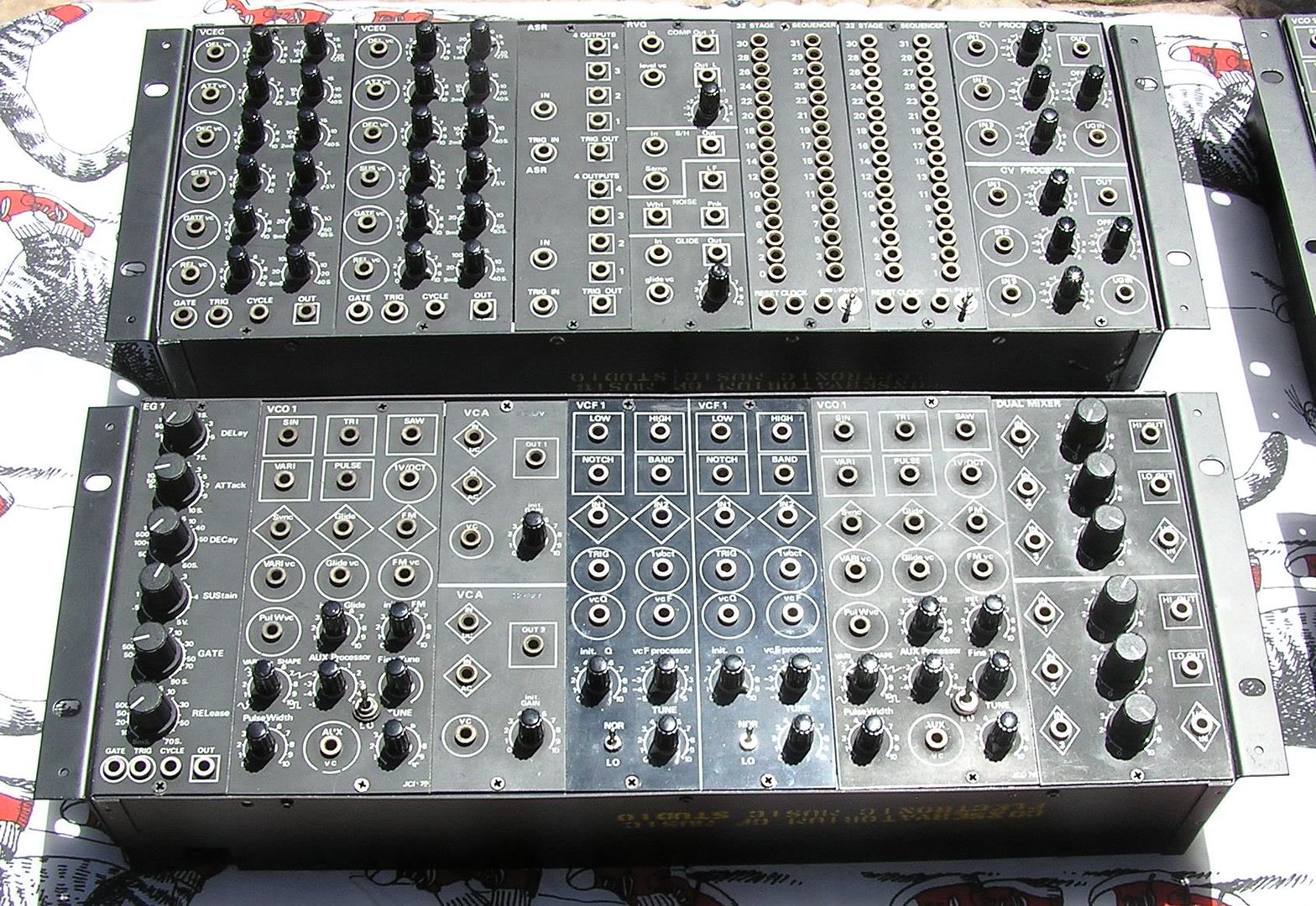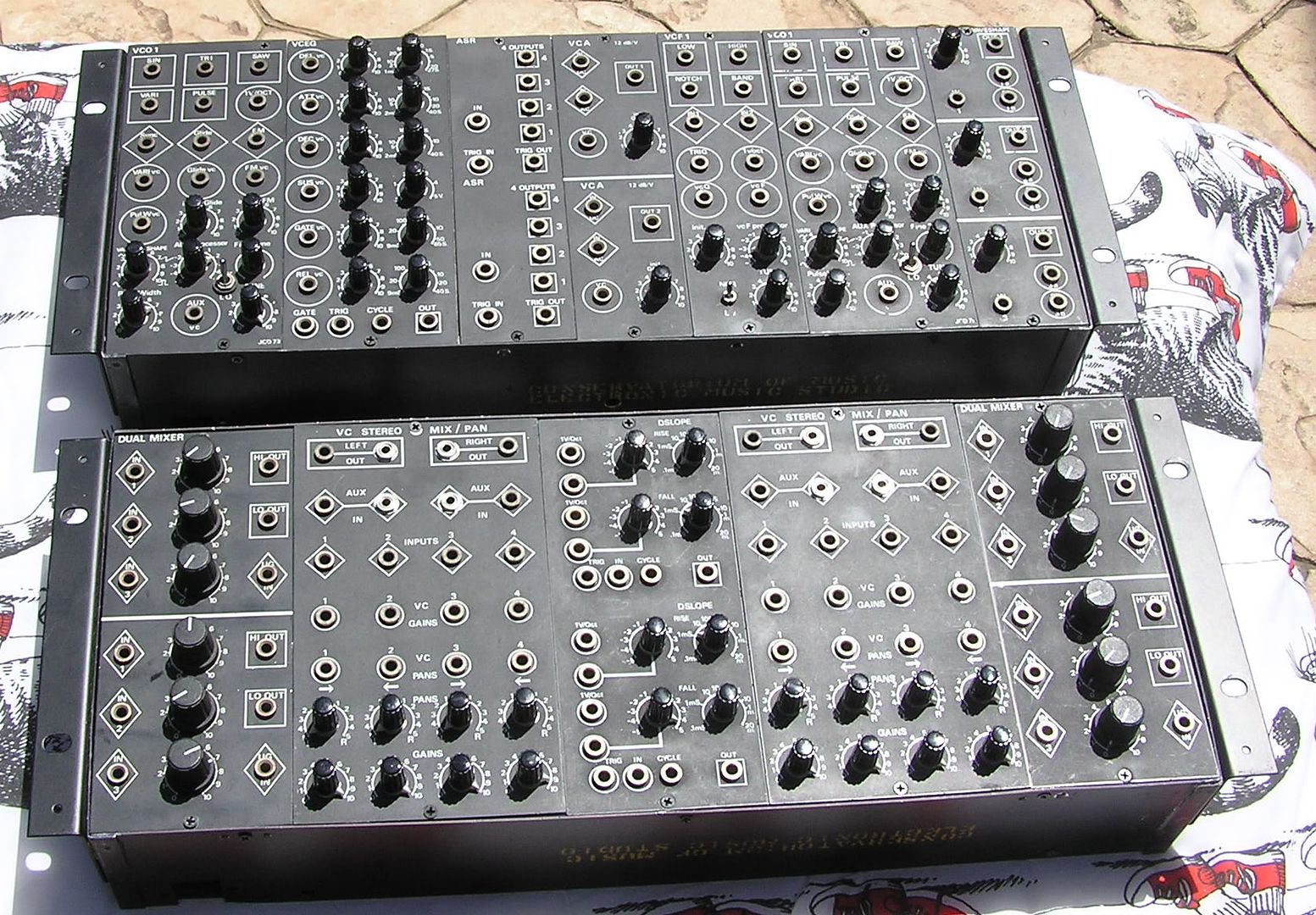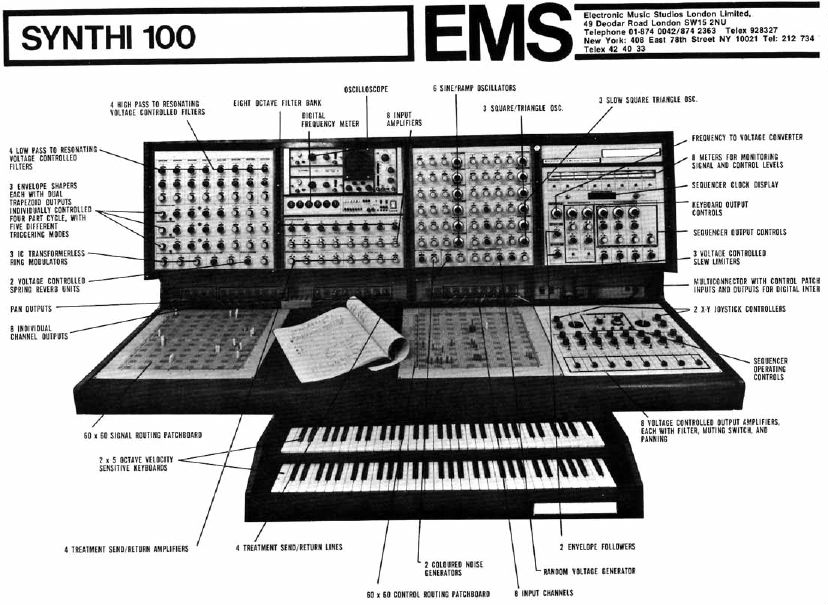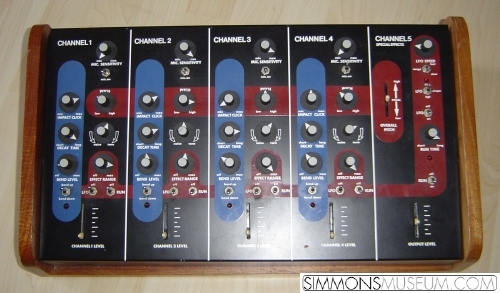Up for grabs is an extremely rare collection of Driscoll Modular panels. Driscoll modules are largely based on Serge designs although there are some significant differences! These were produced in 1979 and I purchased them a few years ago from a guy in Sydney, Australia. The chassis' they came in read "Conservatorium of Music Electronic Music Studio" on the side so I believe they lived at a university there for most of the first part of their lives. When I received them they were ~50% functional and I have restored them to full functionality over the past few years. I'm only aware of 3 other people that have any Driscoll, and this is the largest collection of them so this is your chance to own the most Driscoll in the world!
The panels contain modules as follows:
Panel 1 (voice) $3300
2x VCO 1
1x EG1
1x Dual VCA
2x VCFQ
1x Dual Mixer
Panel 2 (voice) $3300
1x VCO 1
1x VCEG
1x ASR
1x TWS (triple waveshaper)
1x Dual VCA
1x VCFQ
1x Dual Mixer
Panel 3 (drums) $3100
1x CV Proc
2x 32 Stage Sequencer
3x VCF 1 (VCFQ)
1x Dual Mixer
1x Interface
Panel 4 (CV) $3000
2x VCEG
1x RVG
1x ASR
2x 32 Stage Sequencer
1x CV Proc
Panel 5 (mixer/stereo/quad output stage) $3200
1x Dual Slope
2x Dual Mixer
2x VC 4 channel stereo mixer/panner
This panel is set up really nicely to do a quad output stage with one VC mixer for front/back and the other for left/right and the DSG providing 2 CV sources to make things swirl!
As you can see in the pictures, all the banana jacks are uninsulated (soldered to the rear of the front panel) so they are super playable! Just touch the tip of the banana cable to the jack edge and the connection is made.
These panels use the full 17 inches of panel space for the modules, so the function density is higher than Serge panels, especially M-odules.
Some notes on the modules…
The Oscillators are like the NTO but with some really nice additional features. It has a pulse wave output with manual and CV control over pulse width, sync input, and a hi/low switch to move between LFO and audio ranges. These are probably less stable than an NTO but I've found they get pretty stable after some time to warm up.
The Voltage Controlled Envelope Generators have CV inputs for each stage like the Serge ADSR, but the Driscoll also has gain control over each CV input. There is no slope toggle on the Driscoll, but there is a cycle jack that outputs a pulse at the end of the envelope which you can patch back into the trig input to get LFO type behavior.
The 32 Stage Sequencer is something that is unique to the Driscoll system. It is a bidirectional 1 input to 32 output or 32 input to 1 output analog switch with clock and reset inputs to drive the switching. There is also a toggle switch to put 5 volts at the input stage. These are great for switching between signal sources, routing triggers to different destinations, or break the "don't stack on inputs" rule and patch different points on them to the inputs on a VCF 1 to get sequenced drums with high resolution on the timing.
The VCA's have both DC and an AC inputs so it can be a simple mixer too.
The ASR is much like the Serge ASR, but it has 4 stages over the 3 on the Serge ASR but with no gain control on the input signal.
The RVG contains a comparator, sample and hold, white noise, pink noise, low frequency noise, and a glide circuit. The sample and hold is a bit different than other S&H's I've used. This one holds while the clock input is high, but lets the input signal pass freely while the clock is low. This makes for a lot of fun while modulating the PWM on the clock signal! Also, I think the comparator hi/low state is inverted compared to the Serge comparator.
And and audio demo of the Oscillators as bass:
http://www.fabrique.jp/~ab/driscoll_bass_example.mp3
PSU is +/-15v, +5v
CV is 0-5v
Oscillators are +/- 2.5v
Unlike Serge systems, each module has it's own panel so you can rearrange the system at will. I've prepared some power distro boards for each panel so each module has it's own connector to the distro board. No serial wiring like Serge. There is room on each distro board for several more connectors, one of which I can set up for the type of connector used on your existing power supply (if you have one). I could also set up a regulator for the 5v rail if your supply is only +/-15v.
Each front panel is actually a single sided PCB with front panel graphics silkscreened on one side, and traces on the other. Circuit boards are mounted in card slots that are soldered to the rear of the front panel. All panel mount components are soldered to the panel which mean no flying wires to the panel, very clean and lightweight design. Almost all the IC's on the boards are socketed so repairs are much faster and easier. Here are some pics of the backside of a module: Guts 1 Guts 2 Guts 3
The boxes they come in have rack ears but are slightly larger (.1 inches) than 4 rack spaces so they don't fit in a rack without a little space between them. There are other case options that I can discuss with buyers considering multiple panels.
I am keeping 2 panels of modules as they are just too cool to let them all go, but I am selling these because I actually have 7 panels worth of modules which is simply more than I need. I also need to fund some life changes










